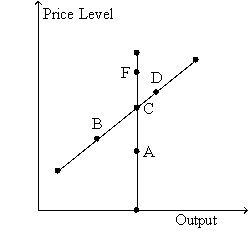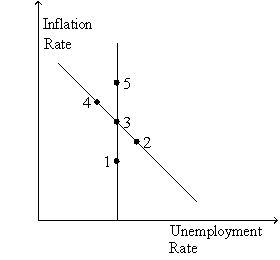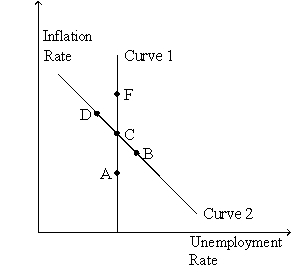A) A contractionary monetary policy will lead to higher unemployment in the short-run but not the long-run.
B) An expansionary monetary policy will lead to higher unemployment in the short-run but not the long-run.
C) Expected inflation is higher than otherwise if the public believes that policymakers will be tempted to raise inflation to reduce unemployment.
D) Expected inflation is lower than otherwise if the public believes that policymakers will be tempted to lower inflation to reduce unemployment.
F) A) and C)
Correct Answer

verified
Correct Answer
verified
Multiple Choice
Friedman argued that the Fed could use monetary policy to peg
A) nominal exchange rates.
B) the level of real GDP.
C) the rate of unemployment.
D) None of the above is correct.
F) A) and B)
Correct Answer

verified
Correct Answer
verified
Multiple Choice
Which of the following is correct concerning the long-run Phillips curve?
A) Its position is determined primarily by monetary factors.
B) If it shifts right,long-run aggregate supply shifts right.
C) It cannot be changed by any government policy.
D) Its position depends on the natural rate of unemployment.
F) B) and D)
Correct Answer

verified
Correct Answer
verified
Multiple Choice
There is a
A) short-run tradeoff between inflation and unemployment.
B) short-run tradeoff between the actual unemployment rate and the natural rate of unemployment.
C) long-run tradeoff between inflation and unemployment.
D) long-run tradeoff between the actual unemployment rate and the natural rate of unemployment.
F) B) and C)
Correct Answer

verified
Correct Answer
verified
Multiple Choice
According to the long-run Phillips curve,in the long run monetary policy influences
A) both the inflation rate and the unemployment rate.
B) the inflation rate but not the unemployment rate.
C) the unemployment rate but not the inflation rate.
D) neither the unemployment rate nor the inflation rate.
F) A) and C)
Correct Answer

verified
Correct Answer
verified
Multiple Choice
If inflation expectations rise,the short-run Phillips curve shifts
A) right,so that at any unemployment rate inflation is higher in the short run than before.
B) left,so that at any unemployment rate inflation is higher in the short run the before.
C) right,so that at any unemployment rate inflation is lower in the short run than before.
D) left,so that at any unemployment rate inflation is lower in the short run than before.
F) B) and C)
Correct Answer

verified
Correct Answer
verified
True/False
Friedman and Phelps believed that the natural rate of unemployment was constant.
B) False
Correct Answer

verified
Correct Answer
verified
Multiple Choice
An adverse supply shock will cause output
A) and prices to rise.
B) and prices to fall.
C) to rise and prices to fall.
D) to fall and prices to rise.
F) B) and C)
Correct Answer

verified
Correct Answer
verified
Multiple Choice
If the Federal Reserve decreases the rate at which it increases the money supply,then unemployment is higher in
A) the long run and the short run.
B) the long run but not the short run.
C) the short run but not the long run.
D) neither the short run nor the long run.
F) A) and B)
Correct Answer

verified
Correct Answer
verified
Multiple Choice
The economy will move to a point on the short-run Phillips curve where unemployment is lower if
A) the inflation rate decreases.
B) the government increases its expenditures.
C) the Fed decreases the money supply.
D) None of the above is correct.
F) B) and D)
Correct Answer

verified
Correct Answer
verified
Multiple Choice
Which of the following would not be associated with a favorable supply shock?
A) the short-run Phillips curve shifts left
B) unemployment falls
C) the price level rises
D) output rises.
F) B) and D)
Correct Answer

verified
Correct Answer
verified
Multiple Choice
Figure 35-5
Use the two graphs in the diagram to answer the following questions. 
 -Refer to Figure 35-5.Starting from C and 3,in the short run,an unexpected decrease in money supply growth moves the economy to
-Refer to Figure 35-5.Starting from C and 3,in the short run,an unexpected decrease in money supply growth moves the economy to
A) A and 1.
B) B and 2.
C) back to C and 3.
D) D and 4.
F) A) and C)
Correct Answer

verified
Correct Answer
verified
Multiple Choice
Suppose that the money supply increases.In the short run this decreases unemployment according to
A) both the short-run Phillips curve and the aggregate demand and aggregate supply model.
B) neither the short-run Phillips curve nor the aggregate demand and aggregate supply model.
C) the short-run Phillips curve,but not the aggregate demand and supply model.
D) the aggregate demand and aggregate supply model,but not the short-run Phillips curve.
F) All of the above
Correct Answer

verified
Correct Answer
verified
Multiple Choice
The natural rate of unemployment
A) is constant over time.
B) varies over time,but can't be changed by the government.
C) is the unemployment rate that the economy tends to move to in the long run.
D) depends on the rate at which the Fed increases the money supply.
F) None of the above
Correct Answer

verified
Correct Answer
verified
Multiple Choice
Figure 35-4
Use the graph below to answer the following questions.  -Refer to Figure 35-4.If the economy starts at C and the money supply growth rate increases,in the long run the economy
-Refer to Figure 35-4.If the economy starts at C and the money supply growth rate increases,in the long run the economy
A) stays at C.
B) moves to B.
C) moves to F.
D) None of the above is consistent wit an increase in the money supply growth rate.
F) A) and C)
Correct Answer

verified
Correct Answer
verified
Multiple Choice
The position of the long-run Phillips curve and the long-run aggregate supply curve both depend on
A) the natural rate of unemployment and monetary growth.
B) the natural rate of unemployment,but not monetary growth.
C) monetary growth,but not the natural rate of unemployment.
D) neither monetary growth nor the natural rate of unemployment.
F) C) and D)
Correct Answer

verified
Correct Answer
verified
Multiple Choice
If a central bank attempts to lower the inflation rate but the public doesn't believe the inflation rate will fall as far as the central bank says,then in the short run unemployment
A) rises.As inflation expectations adjust,the short-run Phillips curve shifts right.
B) rises.As inflation expectations adjust,the short-run Phillips curve shifts left.
C) falls.As inflation expectations adjust,the short-run Phillips curve shifts right.
D) falls.As inflation expectations adjust,the short-run Phillips curve shifts left.
F) A) and D)
Correct Answer

verified
Correct Answer
verified
Multiple Choice
Refer to Monetary Policy in Southland.Suppose the Southland Department of Finance has run a public relations campaign claiming it will reduce inflation to 12.5% and actually reduces inflation to that level.Suppose at first that the public thought inflation would only drop to 18%,but eventually become convinced that the inflation rate will stay at 12.5%.
A) unemployment rises in the short run,and remains higher than it's original value in the long run.
B) unemployment rises in the short run,and is the same as it's original value in the long run.
C) unemployment falls in the short run,and is lower than it's original value in the long run.
D) unemployment falls in the short run,and is the same as it's original value in the long run.
F) A) and B)
Correct Answer

verified
Correct Answer
verified
Multiple Choice
Figure 35-4
Use the graph below to answer the following questions.  -Refer to Figure 35-4.Curve 1 is the
-Refer to Figure 35-4.Curve 1 is the
A) long-run aggregate supply curve.
B) short-run aggregate supply curve.
C) long-run Phillips curve.
D) short-run Phillips curve.
F) B) and D)
Correct Answer

verified
Correct Answer
verified
Multiple Choice
Germany has a higher natural rate of unemployment than the United States.This suggests that
A) Germany is at a higher point on its long-run Phillips curve and so has higher inflation than the United States.
B) Germany is at a lower point on its long-run Phillips curve and so has lower inflation than the United States.
C) Germany's Phillips curve is to the left of that of the United States,possibly because they have higher inflation.
D) Germany's Phillips curve is to the right of that of the United States,possibly because they have more generous unemployment compensation.
F) B) and C)
Correct Answer

verified
Correct Answer
verified
Showing 121 - 140 of 306
Related Exams